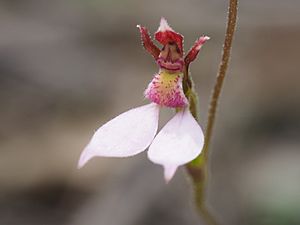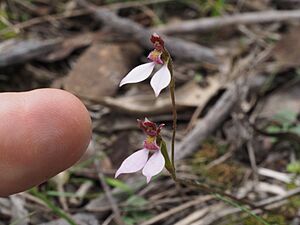Parson's bands facts for kids
Quick facts for kids Parson's bands |
|
|---|---|
 |
|
| Eriochilus cucullatus growing near Dangars Falls | |
| Scientific classification | |
| Genus: |
Eriochilus
|
| Species: |
cucullatus
|
| Synonyms | |
|
Epipactis cucullata Labill. |
|
The Parson's bands orchid, also called Eriochilus cucullatus, is a special plant. It belongs to the amazing orchid family. You can only find this plant in Australia, which means it is endemic there.
This orchid is quite common and grows in many places. It is a slender plant that grows from the ground. It has one leaf and usually grows up to five small flowers. These flowers can be white or a light pink color. You can find Parson's bands in all Australian states, except for Western Australia and the Northern Territory.
Contents
What Does Parson's Bands Look Like?
Eriochilus cucullatus is a plant that grows in the ground. It is a perennial plant, which means it lives for more than two years. It is also deciduous, meaning its leaves fall off at certain times. This plant is a herb and has a special underground part called a tuber. A tuber is like a small, swollen stem that stores food.
The orchid has a single leaf. This leaf is shaped like an egg and is dark green. It feels a bit rough and has tiny hairs. Interestingly, the leaf doesn't fully grow until after the plant has finished flowering. When it's fully grown, the leaf is about 15 to 35 millimeters (0.6 to 1.4 inches) long. It is also about 7 to 12 millimeters (0.3 to 0.5 inches) wide.
Up to five flowers grow on a thin stem. This stem can be 100 to 250 millimeters (4 to 10 inches) tall. Each flower is about 15 to 20 millimeters (0.6 to 0.8 inches) long. They are also about 12 to 15 millimeters (0.5 to 0.6 inches) wide. The flowers are usually white or light pink.
The top part of the flower is called the dorsal sepal. It looks like a spoon or a spear. It is about 5 to 8 millimeters (0.2 to 0.3 inches) long. This sepal forms a small hood over the central part of the flower, which is called the column. The two side sepals are larger. They are about 10 to 13 millimeters (0.4 to 0.5 inches) long. These side sepals are white or light pink.
The petals of the flower are reddish-green. They are about 6 to 7 millimeters (0.2 to 0.3 inches) long. The labellum is another part of the flower. It can be white, green, or yellowish. It is about 6 to 8 millimeters (0.2 to 0.3 inches) long. This part is fleshy and has small tufts of red and white hairs. Parson's bands usually flowers from December to June.
How Parson's Bands Got Its Name
This orchid was first officially described in 1805. A scientist named Jacques Labillardière gave it the name Epipactis cucullata. He wrote about it in his book, Novae Hollandiae Plantarum Specimen. Later, in 1871, another scientist, Heinrich Reichenbach, changed its name to Eriochilus cucullatus.
The second part of its scientific name, cucullatus, comes from a Latin word. It means "hooded." This refers to the dorsal sepal, which forms a hood over the flower's column. The common name, "parson's bands," is also interesting. It refers to the white or pink side sepals. These sepals look a bit like a clerical collar, which is a white band worn by some religious leaders.
Where Parson's Bands Lives
Parson's bands is found in many parts of Australia. It grows widely in Tasmania. In Victoria, you can find it almost everywhere except the far northwest. It also grows in eastern New South Wales, reaching as far west as Grenfell. You can also spot it in southeast Queensland and southeast South Australia.
This orchid can grow in many different places. It lives in grasslands and also in forests. You can find it near the coast and even in subalpine areas. Subalpine zones are high up in mountains, just below the treeline.
Growing Parson's Bands at Home
Some people who love orchids like to grow Eriochilus cucullatus in pots. However, it needs special care and techniques to grow well. It's not an easy plant for beginners to grow.
Images for kids
-
Thomas Chalmers was a Scottish minister. The white bands he is wearing in this portrait are similar to the sepals of the Parson's bands orchid.



